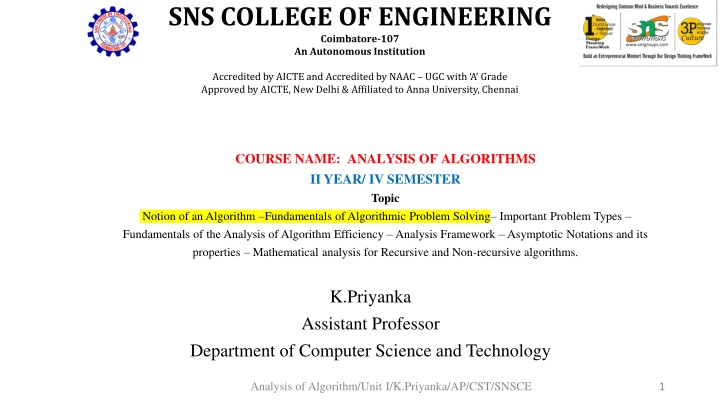
Understanding Algorithms for Efficient Problem Solving
Explore the notion of algorithms, key characteristics, and practical examples in problem solving. Learn the importance of clarity, finite execution, and language independence in algorithm design.
Download Presentation

Please find below an Image/Link to download the presentation.
The content on the website is provided AS IS for your information and personal use only. It may not be sold, licensed, or shared on other websites without obtaining consent from the author. If you encounter any issues during the download, it is possible that the publisher has removed the file from their server.
You are allowed to download the files provided on this website for personal or commercial use, subject to the condition that they are used lawfully. All files are the property of their respective owners.
The content on the website is provided AS IS for your information and personal use only. It may not be sold, licensed, or shared on other websites without obtaining consent from the author.
E N D
Presentation Transcript
SNS COLLEGE OF ENGINEERING Coimbatore-107 An Autonomous Institution Accredited by AICTE and Accredited by NAAC UGC with A Grade Approved by AICTE, New Delhi & Affiliated to Anna University, Chennai COURSE NAME: ANALYSIS OF ALGORITHMS II YEAR/ IV SEMESTER Topic Notion of an Algorithm Fundamentals of Algorithmic Problem Solving Important Problem Types Fundamentals of the Analysis of Algorithm Efficiency Analysis Framework Asymptotic Notations and its properties Mathematical analysis for Recursive and Non-recursive algorithms. K.Priyanka Assistant Professor Department of Computer Science and Technology Analysis of Algorithm/Unit I/K.Priyanka/AP/CST/SNSCE 1
TOPIC1: NOTION OF ALGORITHM Algorithm: Algorithm refers to a sequence of finite steps to solve a particular problem. It is collection of instructions (without proper syntax) that provides output for the given set of input. Output can be either actual result or result with some errors for the given problem. Characteristics of Algorithm: Non-Ambiguity: The algorithm should be unambiguous. Each of its steps should be clear and precise in all aspects and should have no conflict meaning. Well-Defined Inputs and Outputs: An algorithm has zero or more inputs. Range of inputs must be specified. The algorithm must clearly define output that will be yielded. It should produce at least 1 output. Finiteness: The algorithm must terminate after performing operation and producing output in finite time. Analysis of Algorithms/Unit I/K.Priyanka/AP/CST/SNSCE 2
TOPIC1: NOTION OF ALGORITHM Feasible: The algorithm must be simple, generic, and practical, such that it can be executed with the available resources Language Independent: The Algorithm designed must be language-independent, i.e. it must be just plain instructions that can be implemented in any language, Effectiveness: An algorithm must be developed by using very basic, simple, and feasible operations so that one can trace it out easily. It should possess multiplicity. Sections ofAlgorithm: To write an Algorithm, it should include 2 sections. 1. Algorithm Heading 2. Algorithm Body Algorithm heading includes name, problem description, input and output. Algorithm body comprises of Programming constructs and Operators. Datatypes need not to be included. Programming Constructs include if, for, if..else and while statements. Analysis of Algorithms/Unit I/K.Priyanka/AP/CST/SNSCE 3
Simple Example: TO DESIGNAN ALGORITHM TO VERIFYANUMBER IS EVEN OR ODD. Algorithm evenodd(num)//Algorithm Heading //Problem Description: To verify whether a number is even or odd //Input: Get an Input num; //Output: To check whether a given number is even or odd START //Algorithm Body if(num%2==0) display( Number is Even ) else display( Number is Odd ) END Analysis of Algorithms/Unit I/K.Priyanka/AP/CST/SNSCE 4
TOPIC 2-FUNDAMENTALS OF ALGORITHMIC PROBLEM SOLVING While designing and analysing an algorithm, the following steps are to be followed, 1.Understanding the Problem This is the first step in designing of algorithm. Read the problem s description carefully to understand the problem statement completely. Identify the problem types and use existing algorithm to find solution. 2.The Decision making Choice of the Computational Device is done for running different forms of algorithm. *sequential algorithms *parallel algorithms. Choosing between Exact and Approximate Problem Solving: *Exact algorithm *Approximation algorithm Analysis of Algorithms/Unit I/K.Priyanka/AP/CST/SNSCE 5
TOPIC 2-FUNDAMENTALS OF ALGORITHMIC PROBLEM SOLVING Choosing Data Structures &Algorithm Design Techniques Data Structures is categorized as Linear Data Structure (e.g. Stack, Queue) and Non-Linear Data Structure (e.g. Tree, Graph) Algorithmic Strategy includes (E.g., Brute Force, Divide and Conquer, Dynamic Programming, Greedy Technique). Choose Methods of Specifying an Algorithm a. Natural language b. Pseudocode c. Flowchart 3. Proving an Algorithm s Correctness use mathematical induction because an algorithm s iterations provide a natural sequence of steps needed for such proofs. 4. Analyze an Algorithm: An algorithm is defined as complex based on the amount of Space and Time it consumes. Analysis of Algorithms/Unit I/K.Priyanka/AP/CST/SNSCE 6
TOPIC 2-FUNDAMENTALS OF ALGORITHMIC PROBLEM SOLVING Time complexity refers to the amount of time required by the algorithm to execute and get the result. This can be for normal operations, conditional if-else statements, loop statements, etc. Space Complexity refers to the amount of memory required by the algorithm to store the variables and get the result. This can be for inputs, temporary operations, or outputs. Two Forms of Analysis of Complexity: Mathematical Analysis: calculates basic operation and find recurrence relation. Then it uses any of the 2 methods to find its Time Complexity. 1.Master Theorem 2.Substitution Method Note: The Above 2 methods calculate efficiency (Complexity) of Recursive Algorithms only. Analysis of Algorithms/Unit I/K.Priyanka/AP/CST/SNSCE 7
TOPIC 2-FUNDAMENTALS OF ALGORITHMIC PROBLEM SOLVING Empirical Analysis: Empirical Analysis is Solved by Frequency Count Method by 1. Counting the number of loops 2.Iterations made by all the loops and statements within the loops. Note: Empirical Analysis and Summation(Mathematical Analysis)can be used to find efficiency(complexity) of Non Recursive algorithm only. 5. Coding an Algorithm: The coding / implementation of an algorithm is done by a suitable programming language like C, C++, JAVA. Standard tricks like computing a loop s invariant, replacing expensive operations by cheap ones should be known to the programmer. Analysis of Algorithms/Unit I/K.Priyanka/AP/CST/SNSCE 8
21-10-2024 UNIT IV- ATCD 9/22
